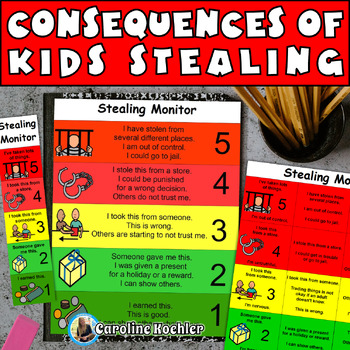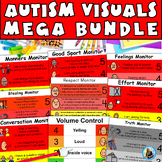Consequences on Stealing Problem Social Stories Lesson Support for Honesty
- PDF
Also included in
- The autism behavior management and monitoring visuals packet is a must for the classroom teacher and caregivers of individuals with autism and other special needs. These visuals teach students social skills, self-regulation, and what behaviors are expected of them. These visuals can be life changiPrice $42.99Original Price $80.50Save $37.51
- The Stealing and Lying Bundle, a comprehensive and engaging tool designed to educate and instill valuable life skills in children. This bundle includes a set of visual scales that helps kids understand the different levels of stealing and the importance of telling the truth versus lying. The StealinPrice $5.99Original Price $7.00Save $1.01
Description
Do you have students or children who have a stealing problem and to learn the consequences on stealing? Do you know individuals who have begun stealing or steal often, and need an extra explanation and visual to discuss the significance and consequences of stealing? This social stories support tool is effective for both young and old general education students and students with learning disabilities including autism.
The Consequences on Stealing Monitor includes
★ 1 small stealing monitor
★ 1 large (8.5*11) stealing chart
★ 1 large detailed stealing chart for teaching purposes
★ Directions for utilizing the stealing chart
Print the desired chart to use depending on the student's ability level and need. Glue the printed chart on construction paper or cardstock. Laminate and cut out. Use the supplied arrow and tape it to a clothespin. This allows the teacher to move the arrow to the appropriate category. If a clothespin is to cumbersome, use a paperclip to easily move around.
I highly recommend that this tool be used in a discussion format with the teacher and student talking through the issues. Then after teaching moments, the tool can be used in real situations to help the student monitor his or her behavior.
See what happy buyers are saying about the Stealing Monitor
“This was a great visual to help my client see what could happen if his stealing behavior escalated outside of the home. I think he got that he could end up in jail/juvenile detention if he wasn't careful and didn't stop, a point we had desperately been trying to make.”
“Perfect for child therapist”
“Great help with a stressful situation!”
“It was a great visual aid to use to discuss stealing.”
"Perfect for a quick lesson on how stealing can escalate- consequences"
Related Products
⭐ Autism Visual Monitor MEGA Bundle: Teach Appropriate Behavior (Aspergers, ED)
⭐ Social Narrative MEGA Set: G-R-O-W-I-N-G BUNDLE for Autism + Special Needs
⭐ Autism Classroom Mega Bundle: Set up, Organize, & Manage; Visuals, Schedules
⭐ Effective Behavior Management Bundle:Printables for Autism, Aspergers, ADD, ADHD
Please remember to FOLLOW ME on TPT for product updates and sales. Then review and rate this product to receive TPT credits!
Interested in tips on special education, autism, behavior management & all things teaching?
Of course, you are!
Check out Caroline’s blog at www.celavora.com.
Follow me on Facebook at Caroline Koehler's TPT store for tips, tricks, and educational fun!







